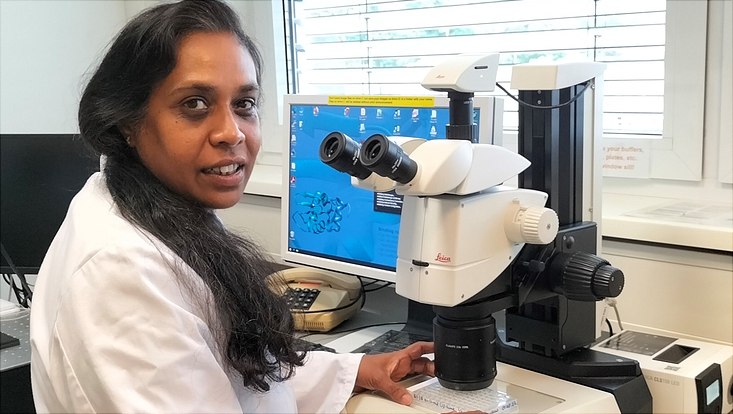18 August 2022
Important enzyme blocked in lab testsResearchers Discover Naturally Occurring Substances Against Coronavirus

Photo: UHH/Gevorgyan
The research team headed by Prof. Dr. Christian Betzel from Universität Hamburg and Dr. Alke Meents from DESY has conducted extensive screening of a large library of naturally occurring substances. “We have tested 500 substances in the Karachi Library of Natural Compounds to see if they bind to the papain-like protease of the novel coronavirus, which is one of the main targets for an antiviral drug,” explains the study’s main author, Dr. Vasundara Srinivasan from Universität Hamburg. “A compound that binds to the enzyme at the right place can stop it from working.”
The papain-like protease (PLpro) is a crucial enzyme in virus replication. When the coronavirus hijacks a cell, it forces the cell to produce building blocks for new virus particles: the proteins are produced in the form of a long string. PLpro works like molecular scissors, cutting the string into little pieces. If this process is blocked, the proteins cannot assemble new virus particles.
For the experiments, the PLpro enzyme was combined with each of the 500 natural substances so that each had an opportunity to bind. You cannot determine if a substance binds to the enzyme, however, using a conventional microscope. Thus, tiny crystals were created from the mixtures. When illuminated with the bright X-rays from PETRA III at DESY, the crystals produced a characteristic diffraction pattern from which the structure of the enzyme can be reconstructed down to the level of individual atoms. “From this information we can produce 3-dimensional models of the enzyme with atomic resolution and see if and where a substance binds to it,” explains Meents.
Three substances could, indeed, bind to the enzyme: Hydroxyethylphenol (YRL), isolated from the henna tree Lawsonia alba, can also be found in red wine and olive oil. It is used as anti-arrhythmia agent. Hydroxybenzaldehyde (HBA) was isolated form the copperleaf Acalypha torta and is a known anti-tumor agent. Methyldihydroxybenzoate (HE9), isolated from the French marigold Tagetes patula, is an anti-oxidant with anti-inflammatory effect and is found in green tea. In laboratory tests, these substances slowed down the activity of PLpro in living cells by 50 to 70 percent.
“The advantage of these substances is their proven safety,” says Prof. Dr. Christian Betzel, who is also a member of the Cluster of Excellence CUI: Advanced Imaging of Matter at Universität Hamburg. “These compounds naturally occur in many foods. However, drinking green tea will not cure your corona infection! Like it will not heal your wounds or cure your cancer. If and how a corona drug can be developed from these phenols is subject to further studies.”
In the study, scientists from Universität Hamburg, the University of Sao Paulo in Brazil, Diamond Light Source in the United Kingdom, European XFEL, Bahauddin Zakariya University in Pakistan, Hospital Israelita Albert Einstein in Brazil, Scientific Platform Pasteur in Brazil, the European Molecular Biology Laboratory in Hamburg, Fraunhofer Institute for Translational Medicine and Pharmacology in Hamburg, Jozef Stefan Institute in Slovenia, Centre of Excellence for Integrated Approaches in Chemistry and Biology of Proteins in Slovenia, the University of Greifswald, and DESY contributed to the work.
Link to original publication (English)
